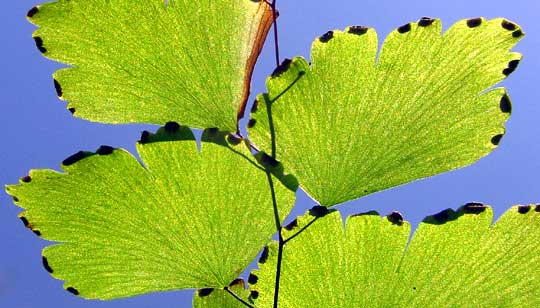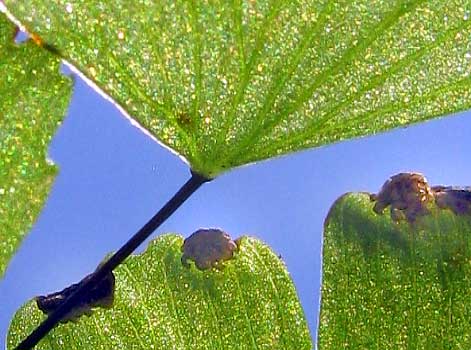Excerpts from Jim Conrad's
Naturalist Newsletter

from the March 14, 2010 Newsletter issued from Hacienda Chichen Resort beside Chichén Itzá Ruins, central Yucatán, MÉXICO; limestone bedrock, elevation ~39m (~128ft), ~N20.676°, ~W88.569°
BRITTLE MAIDENHAIR
Here we have an old-fashioned well with a pulley attached to an arc over it so water can be drawn up by hand with a rope and bucket. Old maps indicate that the well was dug back in the 1500s -- 24.5 meters down (80 feet) through sheer limestone rock -- and you wonder just how they did it. Most of the way down the well is square, but toward the bottom opens into an urn shape. Looking into the well, you see what's shown above.
The well is practically closed by maidenhair ferns. The bucket passes through the center without problems, however, so the ferns are permitted to stay.
This January we looked at a maidenhair species growing at Hacienda Chichen on a stone wall. You can see it at www.backyardnature.net/yucatan/hairmaid.htm.
That was the Hairy Maidenhair, Adiantum tricholeps. The maidenhair in the well isn't hairy at all, and it's different from the Hairy in other important ways, too. For example, in maidenhair ferns -- ferns of the genus Adiantum -- clusters of spore-producing sporangia occur beneath turned-under pinnule tips, the pinnule being the ultimate leaflet of a subdivided (compound) leaf or frond. The Hairy Maidenhair averages only a couple of turned-under sections along each pinnule side, as shown at the page bottom at the last link.
Below you can see that on each pinnule side of our well's maidenhair there are four, five or more turned-under flaps.

The Flora of North America reports that worldwide 150-200 species of maidenhair fern are recognized. Only nine species are listed for North America, and one of those is our well's maidenhair. It's known as the Brittle Maidenhair, ADIANTUM TENERUM.
When identifying our species in the Flora, using an identification key, the key soon asks you whether each pinnule stalk terminates in a "small, cupulelike swelling." A cupule is a small cup. You can see such a cupule atop the diagonal, black stalk at the center of the picture below:

You can hardly see this cupule without a magnifying lens, yet in North America it's enough to know that if you find a maidenhair fern with tiny, cupulelike swellings atop the pinnule stalks, then you have a Brittle Maidenhair. Remembering little tricks like this help a lot when identifying, and help make it so much fun.
Brittle Maidenhairs are so attractive that they're often grown in tropical and semitropical gardens. This species is widespread throughout tropical America and into the subtropical US.